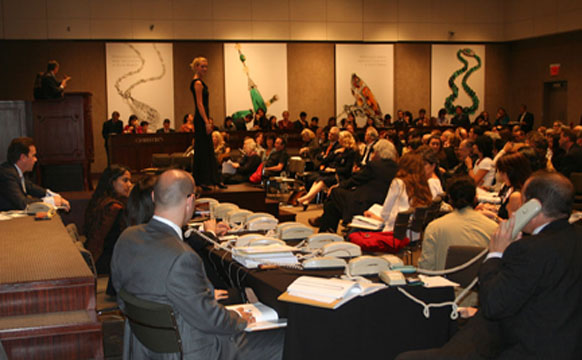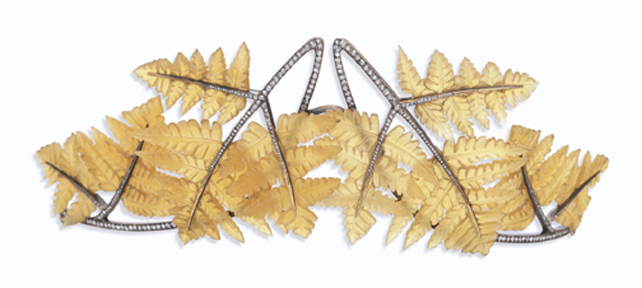
Patricia Hambrecht, a jewelry consultant who worked for Harry Winston and Christie’s for many years, recalls a party she once attended in Argentina where a lovely woman was standing across the terrace. As she moved her head, something caught the light beneath her long hair. Hambrecht strolled over and asked to see her earrings. The woman smiled and said, ‘They are.” Hambrecht replied: “I know.”
The earrings were designed by Joel Arthur Rosenthal, a Bronx-born designer known among jewelry insiders as JAR. “JAR’s jewelry has become, if not a code, a little society all over the world,” Hambrecht explains. She loves how the backs of JAR jewels are always as beautiful as the fronts. “It’s like wearing the best silk lingerie. It’s made for the pleasure of the wearer.”
When the newly-divorced actress Ellen Barkin announced she was selling her jewels from ex-husband Ron Perelman at Christie’s in 2006 – an auction that inspired a scene in the first Sex & the City movie – the media buzz surrounding the sale did not focus on the vintage treasures by Cartier and Van Cleef & Arpels or those once owned by the Duchess of Windsor. It was about 17 pieces by JAR.

Many articles about the designer appeared after the sale was announced but the designer himself did not. Not a word of his was quoted. This surprised no one in the industry, where JAR has long been known for his elusiveness.

When JAR opened his little shop on the Place Vendôme in Paris more than three decades ago, he had no jewelry training. He graduated from Harvard in 1965 with a degree in art history and philosophy and moved to Paris the following year. He has never done any bench work and isn’t much of a draftsman. Former director of jewelry for Christie’s and now head of Christie’s Asia, François Curiel organized the Barkin auction and has known JAR for decades. “He draws like a child,” Curiel admits.
Yet from the beginning, JAR attracted high-profile customers with his unusual sculpted, pavé creations, often using the blackened silver-gold alloy he developed. He never produces more than about 70 pieces a year and half are commissions inspired more by his own whims than that of his A-list clients.
Judging from observations by his acquaintances, the man has a waiting list a mile long – and an even longer list of people pining to get on the waiting list. Which may be why his jewelry usually sells for well above estimates when it appears at auction; that’s the only time JAR jewelry is immediately available to anyone who can pay the price.
How did this untrained American designer become bigger news than Cartier and Van Cleef & Arpels? It has something to do with how difficult his jewelry is to get, of course, but also its craftsmanship—JAR is known to send pieces back to the workshop many times—and its quality of being individualistic yet recognizable at the same time.

About half the jewelry JAR produces are special orders. The other half are his own one-of-a-kind designs. “When one wants a piece of jewelry from someone other than one of the major houses, something no one else has or that was designed especially for you, where do you go?” Curiel said before auctioning off the Barkin jewels. “Whenever I ask this question the answer is JAR, JAR and JAR.”
“His clients know they have to wait,” says Saul Goldberg, a diamond dealer whose family, William Goldberg & Co., has been selling stones to JAR for two decades. Goldberg and his father have been trying to predict JAR’s taste in stones for years. “Give him a pear-shape diamond and he’ll say, ‘Cut off the point at the bottom, then show it to me.’ He looks for something exotic. He likes flat stones, not conventional cuts, soft cuts like a cushion or an oval.”
He has even been known to set conventionally-cut diamonds upside down, as he did with Barkin’s wedding ring: four rows of diamonds set with culets pointing up. I tried this ring on before the 2006 sale and it looked lethal, like bejeweled brass knuckles. I couldn’t help wondering if JAR had a sense of foreshadowing when he designed it.
Despite his exclusive clientele, JAR is not a snob, Curiel insists: “He is very amenable…not a high flier.” Goldberg agrees: “He follows his own vision. His clients can’t rush him. He’s not dictated by their whims but by his own. He’s a good model because he shows that if someone wants something bad enough, they’ll wait.”
This post was adapted from a story I wrote for JCK magazine.
Related products


